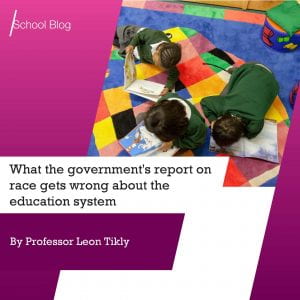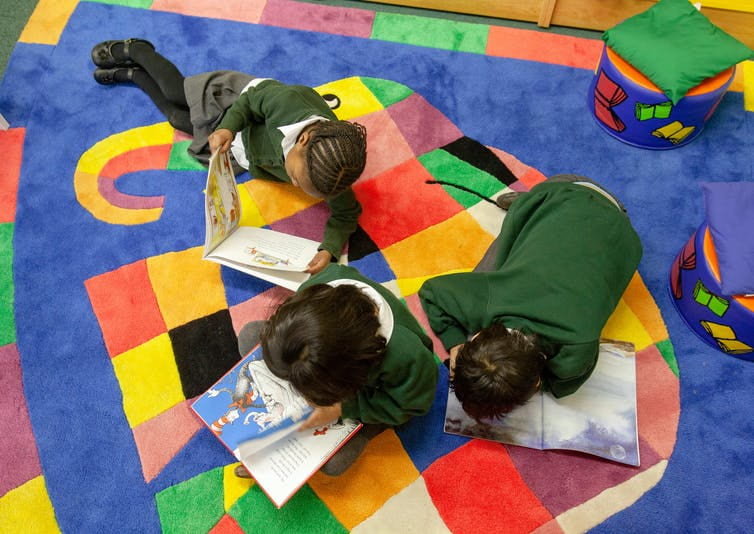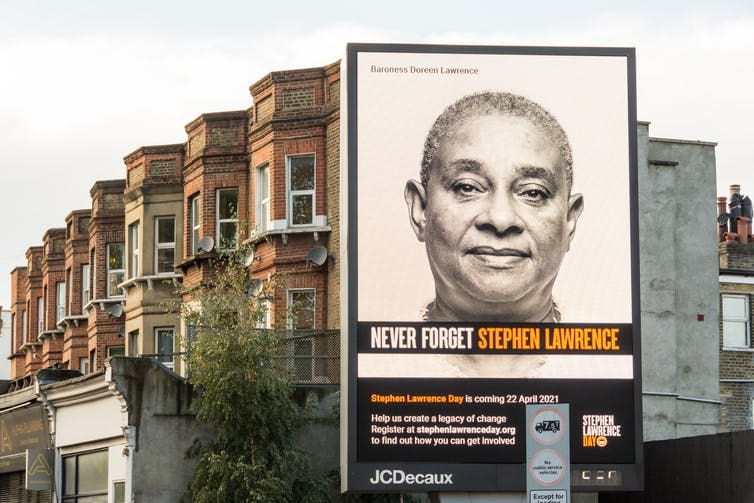 From ‘The Conversation’, by Leon Tikly, University of Bristol
From ‘The Conversation’, by Leon Tikly, University of Bristol
The UK government’s recent report on race, drawn up by the Commission on Ethnic and Racial Disparities, has been roundly criticised for its findings. Its primary claim, as chair Tony Sewell writes in the foreword, that the British system is no longer “deliberately rigged against ethnic minorities” has drawn particular ire.
With regards to education, specifically, the report argues that “if there is racial bias within schools or the teaching profession, it has limited effect”. Sewell’s credentials as an education consultant appear to give special credence to that position. The problem is that it flies in the face of four decades’ worth of research.
As a former science teacher, a university professor and UNESCO Chair in inclusive education – with expertise at local authority, national, European and global levels – I am well placed to unpick quite how flawed Sewell’s statement is.
What the report says
The report focuses primarily on what’s called the attainment gap. Some minority groups (including students of Indian, Chinese and African heritage) outperform their white peers in examinations and in accessing higher education. The authors highlight this as evidence of the absence of institutional racism.
They ascribe the continued underachievement of other groups (including learners of Black Caribbean, dual white/Black Caribbean and Pakistani heritage) to several socio-economic factors: living in disadvantaged neighbourhoods; coming from broken homes; having lower aspirations; and, in the case of Pakistani pupils, a parental failure to properly assimilate into British culture.
The remedy, the authors say, is to do away with unhelpful, catch-all terms such as BAME (Black, Asian and minority ethnic). As opposed to racism, they would have schools focus on getting all students from poorer backgrounds to achieve better results.
They identify several ways of doing so. Improved behavioural and disciplinary policies. An ambitious curriculum with great teaching. Encouraging early reading at primary school level. They also suggest lengthening the school day, improving career guidance and encouraging aspirational thinking in pupils, mainly through enriching the curriculum with more Black, Asian and minority ethnic contributions to contemporary British society.

These are of course laudable suggestions. Social class certainly does affect the majority of both white and Black learners in terms of outcome and opportunity – an issue that needs to be addressed. But by focusing on socio-economic disparity alone, the report side-steps how central an issue racism is.
The report’s omissions
The report claims to be data driven. However it only draws on research that fits the central narrative, while ignoring data that confirms how institutional racism underpins racial disparities.
The report relies heavily on statistical analysis that controls for socio-economic status so as to demonstrate that said status is more important than racism in explaining racial disparities. However, this type of analysis can be misleading and needs to be treated with caution. Correlation is not the same as causation. And understanding the underlying causes for racial disparities requires looking behind the numbers to find out what is actually going on in schools.
Research has consistently shown how stereotypes and low expectations on the part of teachers routinely see Black Caribbean and dual white/ Black Caribbean pupils entered into lower ability sets and exam tiers. Black Caribbean pupils are twice as likely than all their peers, to be temporarily excluded, and four times more likely to be permanently excluded, from school.
Further, all learners of colour are less likely to go to high-status universities. They have poorer university experiences and outcomes. They also face discrimination in the labour market.
The report correctly rejects the reductive effect of the term BAME, but does not extend this insight to recognise how anti-Black and anti-Islamic racism specifically affect Black and Muslim learners.
It correctly identifies the absence of the contributions of people of colour in the making of modern Britain. But it fails to recognise how those accounts of modern Britain whitewash British colonial history. Neither does it address how the self-identity and aspirations of Black and minority ethnic learners can be affected by not seeing themselves represented among the teachers at school.
These acts of bias, absences and omissions are all examples of institutional racism. They follow the definition widely accepted since the 1999 inquiry into the death of black teenager Stephen Lawrence. That is: “The collective failure of an organisation to provide an appropriate and professional service to people because of their colour, culture, or ethnic origin”.

Ideological bias
In questioning the significance of institutional racism, the report puts the onus for underachievement largely on Black Caribbean and Pakistani communities and families. In doing so, it lets school leaders and politicians off the hook.
While schools cannot possibly put right all of the social inequalities that disproportionately affect these communities, they can do something to specifically address racism in their own policies and practices. When they do, it makes a difference.
School leadership has to be prepared to acknowledge racism and commit to race equality. Heads and teachers must make good use of data relating to attainment and exclusions in order to identify both those groups at risk and also those practices that have been successful in helping students and challenging stereotypes.
If a third of under-13s (and more than half of 13-year-olds) have witnessed – or been subjected to – racist comments and bullying at school, schools have to create a safe and inclusive environment where all students are valued and where abuse is dealt with.
They need to provide appropriate support for refugee learners. They need to develop a culturally inclusive curriculum that encourages a balanced appraisal of Britain’s colonial past. They need to actively engage with parents who may themselves lack information about or have have had a negative experience of, the English education system. And they need to equip their staff to understand racism and know how to deal with it.
Students of colour who do succeed do so despite it and not because the system has suddenly become fairer, as this report tries to argue. The real struggle for anti-racism in education continues apace.![]()
 Leon Tikly, Professor in Education, University of Bristol
Leon Tikly, Professor in Education, University of Bristol
This article is republished from The Conversation under a Creative Commons license. Read the original article.
Black Bristol PGCE Scholarship Programme
 The Black Bristol PGCE Scholarship Programme at the School of Education seeks to address the lack of representation of the Black heritage community in higher education across the UK.
The Black Bristol PGCE Scholarship Programme at the School of Education seeks to address the lack of representation of the Black heritage community in higher education across the UK.
It will annually fund Black and mixed-Black heritage students across five areas of the University of Bristol, one of which is the School of Education’s PGCE (Postgraduate Certificate in Education) Initial Teacher Education programme.
How to apply
To find out more, please visit the Black Bristol PGCE Scholarship Programme page .There you will find more information, such as eligibility, and the application form.

